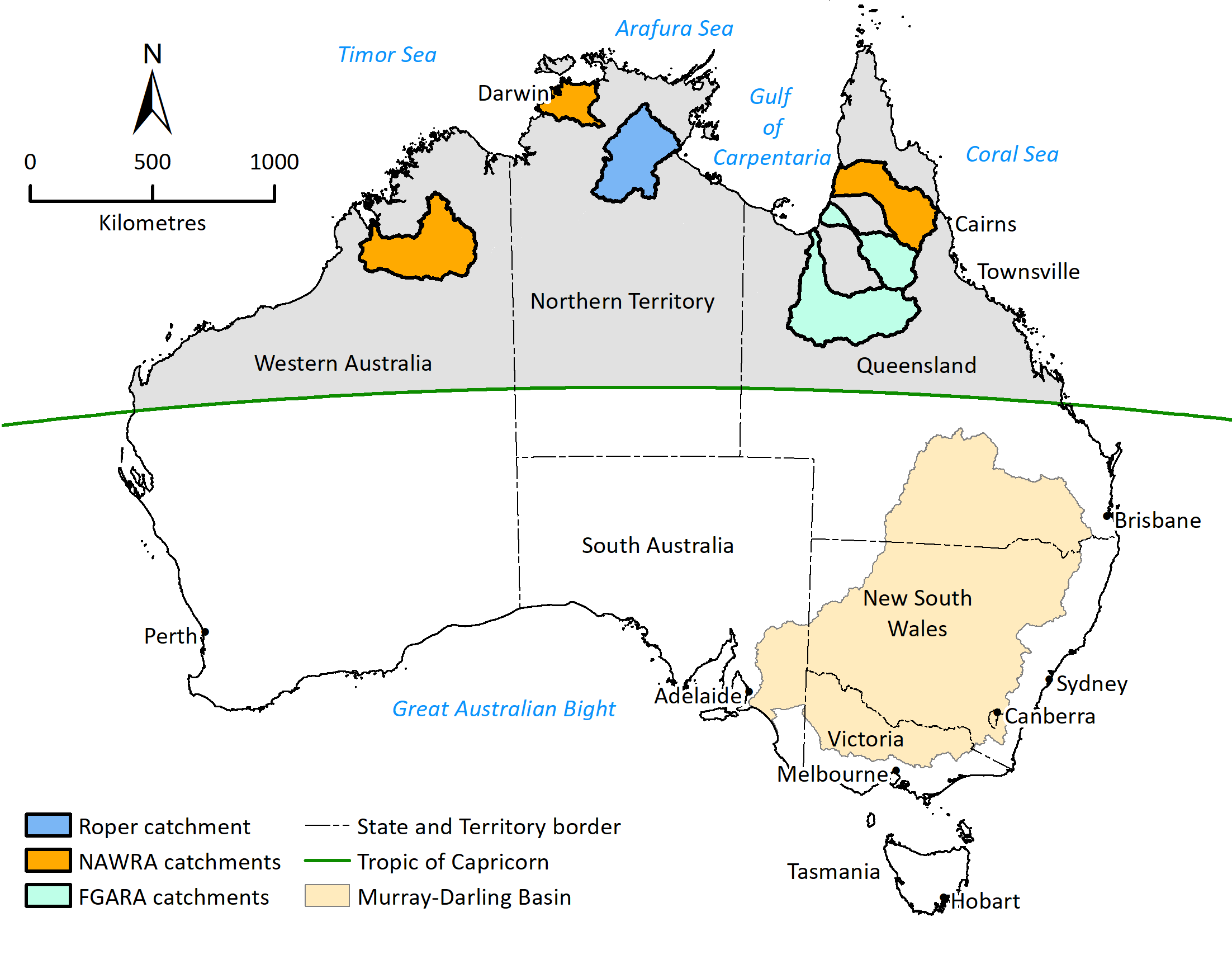Northern Australia makes a substantial contribution to the Australian economy, especially through agriculture, mining, and tourism.
There are opportunities to unlock significant new investment in the north. This requires confidence about the scale and nature of the opportunities, and understanding the risk involved. Millions of hectares are potentially suitable for irrigated agriculture across northern Australia. But access to water is one of several constraints to development.

Following the successful Northern Australia Water Resource Assessment (NAWRA), the Flinders and Gilbert Agricultural Resource Assessment (FGARA), and our work in the Roper River with the Northern Australia Sustainable Yields project, we were engaged by the Australian Government to assess the opportunities for water and agricultural development in the Roper River catchment in the Northern Territory.
The Roper River Water Resource Assessment provides a comprehensive and integrated evaluation of the feasibility, economic viability and sustainability of water and agricultural development in the Roper River catchment. We have worked with the Northern Territory Government, research partners, and communities to complete this assessment. All our findings are publicly available, and we have answered some frequently asked questions.

Assessment goals
Through the Roper River Water Resource Assessment, we:
- evaluated the soil and water resources
- identified and evaluated water capture and storage options
- identified and tested the commercial viability of irrigated agricultural opportunities
- assessed potential environmental, social and economic impacts and risks of water resource and irrigation development.
While agricultural developments may be the most likely to proceed in the foreseeable future, the Assessment also considered opportunities for and intersections between different types of potential water-dependent development. For example, the Assessment explored the nature, scale, location and impacts of developments relating to tourism and agriculture development in relevant locations.
Assessment activities
This is a complex project, drawing on the capabilities of our scientists across Australia as well as experts from within academic, private, and public sector organisations.
Our key activities included:
- surface water modelling, to assess the volume and reliability of river flow
- topographic mapping and automated terrain analysis to identify and evaluate water storage and development options
- mapping land and soil suitability and production risks across agricultural, horticultural, and pastoral systems and for aquaculture developments
- assessing cropping and crop-forage-livestock systems with potential to generate attractive investment returns
- cost-benefit analysis for multiple uses and users of water
- identifying logistical and value chain assets, opportunities and bottlenecks
- understanding the trade-offs between water resource development and freshwater environments
- identifying Indigenous aspirations and water values
- examining the potential for co-benefits to other industries (i.e. tourism) arising from irrigated agriculture
- information and data distribution through Web-based information products, reports and regular community-based information sessions.
The Roper River Water Resource Assessment is an initiative of the Australian Government.
Northern Australia makes a substantial contribution to the Australian economy, especially through agriculture, mining, and tourism.
There are opportunities to unlock significant new investment in the north. This requires confidence about the scale and nature of the opportunities, and understanding the risk involved. Millions of hectares are potentially suitable for irrigated agriculture across northern Australia. But access to water is one of several constraints to development.
Following the successful Northern Australia Water Resource Assessment (NAWRA), the Flinders and Gilbert Agricultural Resource Assessment (FGARA), and our work in the Roper River with the Northern Australia Sustainable Yields project, we were engaged by the Australian Government to assess the opportunities for water and agricultural development in the Roper River catchment in the Northern Territory.
The Roper River Water Resource Assessment provides a comprehensive and integrated evaluation of the feasibility, economic viability and sustainability of water and agricultural development in the Roper River catchment. We have worked with the Northern Territory Government, research partners, and communities to complete this assessment. All our findings are publicly available, and we have answered some frequently asked questions.
Assessment goals
Through the Roper River Water Resource Assessment, we:
- evaluated the soil and water resources
- identified and evaluated water capture and storage options
- identified and tested the commercial viability of irrigated agricultural opportunities
- assessed potential environmental, social and economic impacts and risks of water resource and irrigation development.
While agricultural developments may be the most likely to proceed in the foreseeable future, the Assessment also considered opportunities for and intersections between different types of potential water-dependent development. For example, the Assessment explored the nature, scale, location and impacts of developments relating to tourism and agriculture development in relevant locations.
Assessment activities
This is a complex project, drawing on the capabilities of our scientists across Australia as well as experts from within academic, private, and public sector organisations.
Our key activities included:
- surface water modelling, to assess the volume and reliability of river flow
- topographic mapping and automated terrain analysis to identify and evaluate water storage and development options
- mapping land and soil suitability and production risks across agricultural, horticultural, and pastoral systems and for aquaculture developments
- assessing cropping and crop-forage-livestock systems with potential to generate attractive investment returns
- cost-benefit analysis for multiple uses and users of water
- identifying logistical and value chain assets, opportunities and bottlenecks
- understanding the trade-offs between water resource development and freshwater environments
- identifying Indigenous aspirations and water values
- examining the potential for co-benefits to other industries (i.e. tourism) arising from irrigated agriculture
- information and data distribution through Web-based information products, reports and regular community-based information sessions.
The Roper River Water Resource Assessment is an initiative of the Australian Government.


